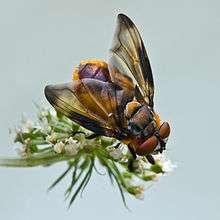Phasia hemiptera
| Phasia hemiptera | |
|---|---|
 | |
| Phasia hemiptera on a flower | |
| Scientific classification | |
| Kingdom: | Animalia |
| Phylum: | Arthropoda |
| Class: | Insecta |
| Order: | Diptera |
| Subsection: | Calyptratae |
| Superfamily: | Oestroidea |
| Family: | Tachinidae |
| Subfamily: | Phasiinae |
| Tribe: | Phasiini |
| Genus: | Phasia |
| Species: | P. hemiptera |
| Binomial name | |
| Phasia hemiptera (Fabricius, 1794) | |
| Synonyms | |
| |
.ogv.jpg)
Female on flowers (Video, 1m 15s)
Phasia hemiptera is a tachinid fly found throughout Northern and Southern Europe. It is a strongly sexually dimorphic species, males being more colourful with curved patterned wings.[1] Like most tachinid flies, the female lays her eggs on other insects, the larvae then develop inside the living host, devouring it and eventually killing it. Its main hosts are the forest bug Pentatoma rufipes in the spring, and the green shield bug Palomena prasina in the autumn.[1][2][3]
References
- 1 2 Øivind Gammelmo & Bjørn Arve Sagvolden (2007). "The tachinid fly Phasia hemiptera (Fabricius, 1794) (Diptera, Tachinidae) in Norway" (PDF). Norwegian Journal of Entomology. 54 (1): 51–54.
- ↑ Belshaw, Robert (1993). "Tachinid Flies Diptera Tachinidae". Royal Entomological Society Handbooks. Royal Entomological Society of London. 10 (4ai): 170.
- ↑ van Emden, F.I. (1954). "Ditera Cyclorrhapha Calyptrata (I) Section (a) Tachinidae & Calliphoridae". Royal Entomological Society Handbooks. Royal Entomological Society of London. 10 (4a): 133.
This article is issued from Wikipedia - version of the 3/10/2015. The text is available under the Creative Commons Attribution/Share Alike but additional terms may apply for the media files.